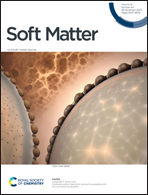Stimuli responsive gelation of tert-butylacetic acid based LMOGs – applications in remediation of marine oil spills, dye removal and heavy metal sensing†
Abstract
Tert-butylacetic acid based amides containing a structural backbone, a hydrogen bonding linker and a bulky end group have been synthesized (TBA1–TBA6) and explored for gelation of fuel oils and organic solvents. The importance of the tert-butyl group in driving the assembly towards gelation has been highlighted in our previously reported pivalamide-based phase selective organogelators (PSOGs). Both groups of compounds have been scrutinized and the effect of an additional methylene group in the newly synthesized series of compounds (on the gelation behavior, single crystal structure, non-covalent interactions responsible for gelation, morphology, dye absorption, etc.) were probed. Compounds TBA1–TBA6 were also utilized for sensing heavy metal ions and transition metal ions present in aqueous medium. They display phase-selective gelation of oil in the presence of biphasic systems (oil–sea water) when added in powder form as well as in solution form, and hence, make excellent candidates for containing oil spills in water bodies. Overall, both these libraries form a class of smallest molecules ever employed for successful organogelation behavior.



 Please wait while we load your content...
Please wait while we load your content...